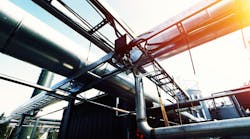Thermal flow meters have carved out a unique niche in the flow meter market due to their ability to help end-users maintain compliance with certain environmental requirements. In the early 1990s, for example, new environmental regulations mandated that companies detect and reduce the emission of sulfur dioxide (SO2) and nitrous oxide (NOX) — both of which were found to be principal causes of acid rain. By combining a measurement of flowrate with a measurement of the concentration of SO2 and NOX, it is possible to determine how much of these substances are released into the atmosphere. As such, by regulating SO2 and NOX emissions, the U.S. Environmental Protection Agency has developed an entire industry around Continuous Emissions Monitoring (CEM). In response to the trend toward CEM, thermal flow meter companies developed multipoint thermal flow meters. In many cases, continuous emissions monitoring occurs in large stacks that emit pollution from industrial sources. Single-point thermal flow meters measure flow at a point, making it difficult to accurately compute flow in a large pipe or smokestack. Multipoint thermal flow meters measure gas flow at multiple points, and use these values to compute flow for the entire pipe, duct or stack. Some multipoint flow meters have as many as 16 measuring points, which enables them to support some of the large smokestack applications require for CEM. Thermal flow meters, due to their insertion style, are one of the few types of flowmeters that can accurately measure gas flow in such large pipes. A New Age of Environmental Awareness While the need for CEM is ongoing, the 21st century has brought new environmental awareness and requirements. Scientific thinking has evolved substantially in the past 10 years, and while global warming and the need to reduce carbon emissions were once viewed as scientific theory, they are now widely accepted as scientific fact. In the United States, for example, the Obama administration has made a commitment to reducing greenhouse gas emission 80 percent by 2050. The new administration is also pledging to make the United States a leader in climate change, which figures to make emissions monitoring a fast-growing application segment for the foreseeable future. Clearly, it is not just in the United States where the effort to reduce greenhouse gas emissions is resulting in market opportunities for thermal flow meter providers. The Kyoto Accord, for example, has resulted in the creation of several mechanisms that require measurement of greenhouse gases internationally. These include Certified Emission Reductions (CER), which is a credit system designed to aid European Union countries in achieving emission limitation targets covered by the European Union Emission Trading Scheme. Another program is the Clean Development Mechanism (CDM), which allows countries to invest in sustainable development projects that reduce emissions in developing countries.
This new age of environmental awareness, together with the Kyoto Accord and other greenhouse gas initiatives, has resulted in a rewriting of the rules on measuring industrial emissions. There is suddenly a need and demand to measure greenhouse gases in applications that formerly may have gone unnoticed. Many of these applications present opportunities for thermal flow meters, including the following:
• Measurement and recovery of landfill gas – Landfills produce carbon dioxide, methane and a mixture of other gases. These gases are measured as they leave the landfills, extracted from different wellheads, and collected to a common header pipe. The collected gases are disposed of or recovered as a fuel source.
• Ethanol distillation and refining – Ethanol production is a complex process involving both fermentation tanks and distillation tanks. Thermal flow meters measure the flow of air and fuel going into the distillation tanks, and the CO2 leaving the fermentation tanks.
• Measuring emissions from steam generators, boilers, and process heaters – Thermal flow meters measure these emissions, especially NOX and carbon monoxide.
• Biomass gasification – Organic industrial waste and food waste can be digested in aerobic conditions in reactor tanks and fermentation towers. The output from this process is called biogas. Biogas includes methane, carbon dioxide, and a mixture of other gases. Thermal flow meters are used to measure gas flow at multiple points along the way, providing optimal production, control and reporting.
• Recovery of methane from coal mines – Methane that is recovered from coal mines often is mixed with air, carbon dioxide, and nitrogen. It is important for accurate flow measurement to calibrate the flow meter with the actual mixture of gases. Thermal flow meters are used to measure the amount of extracted gases recovered from coal mines.
• Monitoring of flue gas – Flues typically are large pipes, stacks, ducts or chimneys that dispose of gases created by a combustion process. Thermal flow meters measure the flow of gases through flues. This is often required by environmental regulations.
• Measurement and monitoring of flare gas flow – Flare systems are used to burn off waste gases from refineries, process plants and power plants. Flares can be a single pipe or a complex network of pipes. Flares are subject to strict environmental regulations. Thermal flow meters are used to measure the amount of gas flared.
The applications noted here provide a mere sampling of the growing number of scenarios that require measurement of greenhouse gases. Thermal flow meters are uniquely suited to make these measurements because their insertion technology allows them to handle large pipe sizes and because they can accurately measure different mixtures of gases. The need for these measurements figures to grow substantially in the next 5-10 years. As a result, so will the demand for thermal flow meters.

